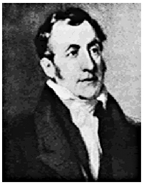Wallich, Nathaniel

Wallich, Nathaniel (1786-1854) was a surgeon and botanist. Nathaniel Wallich born on 28 January 1786 in Copenhagen, Denmark. His father was Wulff ben Wallich (or Wolff Wallich) and mother was Sophia Colling.
Wallich obtained the diploma of the Royal Academy of Surgeons at Copenhagen. At the end of the year of 1807, he was appointed as Surgeon in the Danish settlement at Serampore, then known as Frederiksnagore in Bengal. In 1808, many Danish colonies being seized by the British, including the outpost at Serumpur. Wallich was taken fugitive and later he was paroled and allowed to work for the English East India Company's Bengal medical services. It was also then that botany developed was his main passion, as he became assistant to William Roxburgh, Superintendent of the Calcutta Botanic Garden in 1809. In 1815 he became the superintendent on a temporary basis and in August 1817, Wallich's post as Superintendent was made permanent.
By 1813 he took great interest in the flora and natural vegetation of India, and undertook expeditions to Nepal, Oudh, Rohilkhand and lower Burma. Wallich proposed the forming of a museum in a letter dated 2 February 1814 to the Council of the Asiatic Society. After founding the museum, Dr. Nathaniel Wallich was appointed to be the Honorary Curator and then Superintendent of the Oriental Museum of the Asiatic Society. He took charge of the Museum on 1 June 1814. He was for some time holding joint responsibilities as Superintendent of the Museum and Calcutta Botanical Garden at least unto 1819. Wallich was not only the enthusiastic founder and the first Curator of the oldest museum in India, now known as the Indian Museum; he was one of the largest donors to the Museum at its inception.
Out of one hundred seventy four (174) items donate to the museum till 1816 Wallich donated forty-two botanical specimens. As a botanist of high repute, he prepared a catalogue of more than 20,000 specimens, besides publishing two other important books, namely-Tentamen FlorE6 Nepalensis Illustratae (vols I-II, 1824'26) and PlantE6 AsiaticE6 Rariores (vols I-III, 1830'32).
In 1835 Wallich, William Griffith and John McClelland were sent to evaluate the prospects of growing tea in Assam. Wallich left Calcutta in April 1842 for the Cape and subsequently left for Europe. During his absence William Griffith was nominated to manage the Botanical Garden. Wallich was responsible for packing many of the specimens that came through the gardens on the way to England, and over the years he developed some innovative methods, including packing seeds in brown sugar. The sugar preserved and protected the seeds very well and, Wallich had one of the best records for keeping plant material alive for shipping. Wallich also took an interest in Indian art and history. As the first director of the Oriental Museum of the Asiatic he employed Indian artists and expected them to sign the artwork, although this was not done. His work in India was often rewarding- in 1826 he became the first European known to gather specimens of teak while serving as an envoy to India's Governor-general, Lord Amherst, during the latter's negotiations with Burmese rulers. In the 1830s, under Wallich's stewardship, the Garden made the first systematic attempt to cultivate tea commercially in India.
During 1837 and 1838, Nathaniel Wallich served as Professor of Botany in Calcutta Medical College. He was an honorary doctor at the University of Copenhagen and member of the 'Royal Danish Society of Sciences'. He returned to London in 1847 and breathed his last there on April 28, 1854. [Nasrin Akhter]
